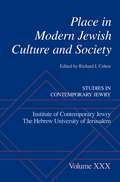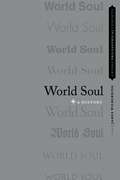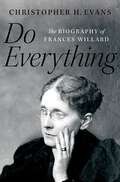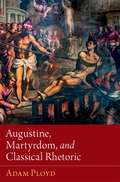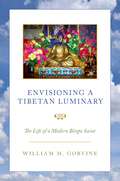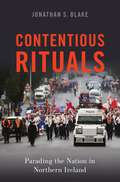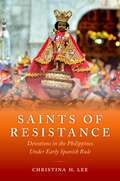- Table View
- List View
Place in Modern Jewish Culture and Society (Studies in Contemporary Jewry)
Notions of place have always permeated Jewish life and consciousness. The Babylonian Talmud was pitted against the Jerusalem Talmud; the worlds of Sepharad and Ashkenaz were viewed as two pillars of the Jewish experience; the diaspora was conceived as a wholly different experience from that of Eretz Israel; and Jews from Eastern Europe and "German Jews" were often seen as mirror opposites, whereas Jews under Islam were often characterized pejoratively, especially because of their allegedly uncultured surroundings. Place, or makom, is a strategic opportunity to explore the tensions that characterize Jewish culture in modernity, between the sacred and the secular, the local and the global, the historical and the virtual, Jewish culture and others. The plasticity of the term includes particular geographic places and their cultural landscapes, theological allusions, and an array of other symbolic relations between locus, location, and the production of culture. The 30th volume of Studies in Contemporary Jewry includes twelve essays that deal with various aspects of particular places, making each location a focal point for understanding Jewish life and culture. Scholars from the United States, Europe, and Israel have used their disciplinary skills to shed light on the vicissitudes of the 20th century in relation to place and Jewish culture. Their essays continue the ongoing discussion in this realm and provide further insights into the historiographical turn in Jewish studies.
Place in Modern Jewish Culture and Society (Studies in Contemporary Jewry)
by Richard I. CohenNotions of place have always permeated Jewish life and consciousness. The Babylonian Talmud was pitted against the Jerusalem Talmud; the worlds of Sepharad and Ashkenaz were viewed as two pillars of the Jewish experience; the diaspora was conceived as a wholly different experience from that of Eretz Israel; and Jews from Eastern Europe and "German Jews" were often seen as mirror opposites, whereas Jews under Islam were often characterized pejoratively, especially because of their allegedly uncultured surroundings. Place, or makom, is a strategic opportunity to explore the tensions that characterize Jewish culture in modernity, between the sacred and the secular, the local and the global, the historical and the virtual, Jewish culture and others. The plasticity of the term includes particular geographic places and their cultural landscapes, theological allusions, and an array of other symbolic relations between locus, location, and the production of culture. The 30th volume of Studies in Contemporary Jewry includes twelve essays that deal with various aspects of particular places, making each location a focal point for understanding Jewish life and culture. Scholars from the United States, Europe, and Israel have used their disciplinary skills to shed light on the vicissitudes of the 20th century in relation to place and Jewish culture. Their essays continue the ongoing discussion in this realm and provide further insights into the historiographical turn in Jewish studies.
Biography of a Mexican Crucifix: Lived Religion and Local Faith from the Conquest to the Present
by Jennifer Scheper HughesIn 1543, in a small village in Mexico, a group of missionary friars received from a mysterious Indian messenger an unusual carved image of Christ crucified. The friars declared it the most poignantly beautiful depiction of Christ's suffering they had ever seen. Known as the Cristo Aparecido (the "Christ Appeared"), it quickly became one of the most celebrated religious images in colonial Mexico. Today, the Cristo Aparecido is among the oldest New World crucifixes and is the beloved patron saint of the Indians of Totolapan. In Biography of a Mexican Crucifix, Jennifer Scheper Hughes traces popular devotion to the Cristo Aparecido over five centuries of Mexican history. Each chapter investigates a single incident in the encounter between believers and the image. Through these historical vignettes, Hughes explores and reinterprets the conquest of and mission to the Indians; the birth of an indigenous, syncretic Christianity; the violent processes of independence and nationalization; and the utopian vision of liberation theology. Hughes reads all of these through the popular devotion to a crucifix that over the centuries becomes a key protagonist in shaping local history and social identity. This book will be welcomed by scholars and students of religion, Latin American history, anthropology, and theology.
World Soul: A History (Oxford Philosophical Concepts)
Many philosophers and scientists over the course of history have held that the world is alive. It has a soul, which governs it and binds it together. This suggestion, once so wide-spread, may strike many of us today as strange and antiquated--in fact, there are few other concepts that, on their face, so capture the sheer distance between us and our philosophical inheritance. But the idea of a world soul has held so strong a grip upon philosophers' imaginations for over 2,000 years, that it continues to underpin and even structure how we conceive of time and space. The concept of the world soul is difficult to understand in large part because over the course of history it has been invoked to very different ends and within the frameworks of very different ontologies and philosophical systems, with varying concepts of the world soul emerging as a result. This volume brings together eleven chapters by leading philosophers in their respective fields that collectively explore the various ways in which this concept has been understood and employed, covering the following philosophical areas: Platonism, Stoicism, Medieval, Indian or Vedântic, Kabbalah, Renaissance, Early Modern, German Romanticism, German Idealism, American Transcendentalism, and contemporary quantum mechanics and panpsychism theories. In addition, short reflections illuminate the impact the concept of the world soul has had on a small selection of areas outside of philosophy, such as harmony, the biological concept of spontaneous generation, Henry Purcell, psychoanalysis, and Gaia theories.
World Soul: A History (Oxford Philosophical Concepts)
by James WilberdingMany philosophers and scientists over the course of history have held that the world is alive. It has a soul, which governs it and binds it together. This suggestion, once so wide-spread, may strike many of us today as strange and antiquated--in fact, there are few other concepts that, on their face, so capture the sheer distance between us and our philosophical inheritance. But the idea of a world soul has held so strong a grip upon philosophers' imaginations for over 2,000 years, that it continues to underpin and even structure how we conceive of time and space. The concept of the world soul is difficult to understand in large part because over the course of history it has been invoked to very different ends and within the frameworks of very different ontologies and philosophical systems, with varying concepts of the world soul emerging as a result. This volume brings together eleven chapters by leading philosophers in their respective fields that collectively explore the various ways in which this concept has been understood and employed, covering the following philosophical areas: Platonism, Stoicism, Medieval, Indian or Vedântic, Kabbalah, Renaissance, Early Modern, German Romanticism, German Idealism, American Transcendentalism, and contemporary quantum mechanics and panpsychism theories. In addition, short reflections illuminate the impact the concept of the world soul has had on a small selection of areas outside of philosophy, such as harmony, the biological concept of spontaneous generation, Henry Purcell, psychoanalysis, and Gaia theories.
The Many Faces of a Himalayan Goddess: Hadimba, Her Devotees, and Religion in Rapid Change (AAR Religion, Culture, and History)
by Ehud HalperinHadimba is a primary village goddess in the Kullu Valley of the West Indian Himalayan state of Himachal Pradesh, a rural area known as the Land of Gods. As the book shows, Hadimba is a goddess whose vitality reveals itself in her devotees' rapidly changing encounters with local and far from local players, powers, and ideas. These include invading royal forces, colonial forms of knowledge, and more recently the onslaught of modernity, capitalism, tourism, and ecological change. Hadimba has provided her worshipers with discursive, ritual, and ideological arenas within which they reflect on, debate, give meaning to, and sometimes resist these changing realities, and she herself has been transformed in the process. Drawing on diverse ethnographic and textual materials gathered in the region from 2009 to 2017, The Many Faces of a Himalayan Goddess is rich with myths and tales, accounts of dramatic rituals and festivals, and descriptions of everyday life in the celebrated but remote Kullu Valley. The book employs an interdisciplinary approach to tell the story of Hadimba from the ground up, or rather, from the center out, portraying the goddess in varying contexts that radiate outward from her temple to local, regional, national, and indeed global spheres. The result is an important contribution to the study of Indian village goddesses, lived Hinduism, Himalayan Hinduism, and the rapidly growing field of religion and ecology.
The Many Faces of a Himalayan Goddess: Hadimba, Her Devotees, and Religion in Rapid Change (AAR Religion, Culture, and History)
by Ehud HalperinHadimba is a primary village goddess in the Kullu Valley of the West Indian Himalayan state of Himachal Pradesh, a rural area known as the Land of Gods. As the book shows, Hadimba is a goddess whose vitality reveals itself in her devotees' rapidly changing encounters with local and far from local players, powers, and ideas. These include invading royal forces, colonial forms of knowledge, and more recently the onslaught of modernity, capitalism, tourism, and ecological change. Hadimba has provided her worshipers with discursive, ritual, and ideological arenas within which they reflect on, debate, give meaning to, and sometimes resist these changing realities, and she herself has been transformed in the process. Drawing on diverse ethnographic and textual materials gathered in the region from 2009 to 2017, The Many Faces of a Himalayan Goddess is rich with myths and tales, accounts of dramatic rituals and festivals, and descriptions of everyday life in the celebrated but remote Kullu Valley. The book employs an interdisciplinary approach to tell the story of Hadimba from the ground up, or rather, from the center out, portraying the goddess in varying contexts that radiate outward from her temple to local, regional, national, and indeed global spheres. The result is an important contribution to the study of Indian village goddesses, lived Hinduism, Himalayan Hinduism, and the rapidly growing field of religion and ecology.
The Subhedar's Son: A Narrative of Brahmin-Christian Conversion from Nineteenth-century Maharashtra (AAR Religion in Translation)
by Deepra DandekarThe 19th century was a pioneering age for vernacular texts in India. Vernacular writings became popular for making the 'first' interventions of their kind, written by Indians for Indians, and establishing new genres such as the biographical novel. The Subhedar's Son, an award-winning Marathi novel, was written in 1895 and published by the Bombay Tract and Book Society, and comprised overlapping personal and political trajectories. The author, Rev. Dinkar Shankar Sawarkar, inscribed multiple viewpoints into his narrative, including that of his own father, Rev. Shankar Nana (1819-1884), a Brahmin who was one of the early converts of the Church Missionary Society in Western India and served the CMS and the Anglican Church in various capacities for many years. Apart from Shankar Nana's conversion-story, Sawarkar provides readers with a blueprint of what a Brahminical journey towards Christian conversion encompassed, while describing his personal background of having lived a Christian life as a product of both Brahminism and Christianity. Attempting to deconstruct Brahmanism through Christianity he claimed Brahmin roots as a Christian with an aim of combatting the stigma of conversion. Contextualized within the early history of Maharashtra's missions and the specificities of individual conversions, the novel allows modern researchers to appreciate the particularity of regional and vernacular Indian Christianity. This culturally-specific Christianity spurred the production of Christian vernacular print culture, associating 'being Marathi' with broader and more universal frameworks of Christianity. But this new genre also produced nativist forms of Christian devotion and piety. Deepra Dandekar introduces this annotated translation of The Subhedar's Son, with an examination of the Church Missionary Society's socio- political context; a biography of Shankar Nana gleaned from archival sources; a brief summary of Sawarkar's biography; and an analysis of the multiple political opinions framing the book.
The Subhedar's Son: A Narrative of Brahmin-Christian Conversion from Nineteenth-century Maharashtra (AAR Religion in Translation)
by Deepra DandekarThe 19th century was a pioneering age for vernacular texts in India. Vernacular writings became popular for making the 'first' interventions of their kind, written by Indians for Indians, and establishing new genres such as the biographical novel. The Subhedar's Son, an award-winning Marathi novel, was written in 1895 and published by the Bombay Tract and Book Society, and comprised overlapping personal and political trajectories. The author, Rev. Dinkar Shankar Sawarkar, inscribed multiple viewpoints into his narrative, including that of his own father, Rev. Shankar Nana (1819-1884), a Brahmin who was one of the early converts of the Church Missionary Society in Western India and served the CMS and the Anglican Church in various capacities for many years. Apart from Shankar Nana's conversion-story, Sawarkar provides readers with a blueprint of what a Brahminical journey towards Christian conversion encompassed, while describing his personal background of having lived a Christian life as a product of both Brahminism and Christianity. Attempting to deconstruct Brahmanism through Christianity he claimed Brahmin roots as a Christian with an aim of combatting the stigma of conversion. Contextualized within the early history of Maharashtra's missions and the specificities of individual conversions, the novel allows modern researchers to appreciate the particularity of regional and vernacular Indian Christianity. This culturally-specific Christianity spurred the production of Christian vernacular print culture, associating 'being Marathi' with broader and more universal frameworks of Christianity. But this new genre also produced nativist forms of Christian devotion and piety. Deepra Dandekar introduces this annotated translation of The Subhedar's Son, with an examination of the Church Missionary Society's socio- political context; a biography of Shankar Nana gleaned from archival sources; a brief summary of Sawarkar's biography; and an analysis of the multiple political opinions framing the book.
Do Everything: The Biography of Frances Willard
by Christopher H. EvansFrances Willard (1839-1898) was one of the most prominent American social reformers of the late nineteenth century. As the long-time president of the Woman's Christian Temperance Union (WCTU), Willard built a national and international movement of women that campaigned for prohibition, women's rights, economic justice, and numerous other social justice issues during the Gilded Age. Emphasizing what she called "Do Everything" reform, Willard became a central figure in international movements in support of prohibition, women's suffrage, and Christian socialism. A devout Methodist, Willard helped to shape predominant religious currents of the late nineteenth century and was an important figure in the rise of the social gospel movement in American Protestantism. The first biography of Frances Willard to be published in over thirty-five years, Do Everything explores Willard's life, her contributions as a reformer, and her broader legacy as a women's rights activist in the United States. In addition to chronicling Willard's life, historian Christopher H. Evans examines how Willard crafted a distinctive culture of women's leadership, emphasizing the importance of religious faith for understanding Willard's successes as a social reformer. Despite her enormous fame during her lifetime, Evans investigates the reasons why Willard's legacy has been eclipsed by subsequent generations of feminist reformers and assesses her importance for our time.
Do Everything: The Biography of Frances Willard
by Christopher H. EvansFrances Willard (1839-1898) was one of the most prominent American social reformers of the late nineteenth century. As the long-time president of the Woman's Christian Temperance Union (WCTU), Willard built a national and international movement of women that campaigned for prohibition, women's rights, economic justice, and numerous other social justice issues during the Gilded Age. Emphasizing what she called "Do Everything" reform, Willard became a central figure in international movements in support of prohibition, women's suffrage, and Christian socialism. A devout Methodist, Willard helped to shape predominant religious currents of the late nineteenth century and was an important figure in the rise of the social gospel movement in American Protestantism. The first biography of Frances Willard to be published in over thirty-five years, Do Everything explores Willard's life, her contributions as a reformer, and her broader legacy as a women's rights activist in the United States. In addition to chronicling Willard's life, historian Christopher H. Evans examines how Willard crafted a distinctive culture of women's leadership, emphasizing the importance of religious faith for understanding Willard's successes as a social reformer. Despite her enormous fame during her lifetime, Evans investigates the reasons why Willard's legacy has been eclipsed by subsequent generations of feminist reformers and assesses her importance for our time.
Augustine, Martyrdom, and Classical Rhetoric
by Adam PloydEarly Christian martyr accounts were less about recounting history than about constructing theology. As such, many historians of late antique Christianity call them "rhetorical." But what does this mean for early Christian theology of martyrdom? And what rhetorical techniques are actually being used for such theological construction? To answer these questions, Adam Ployd looks to Augustine of Hippo. He places Augustine's martyr theology within its classical rhetorical context, drawing upon the theoretical foundations of Cicero, Quintilian, and others. Ployd investigates all of Augustine's major controversies as well as his work as a bishop and preacher cultivating a particular vision of the Christian life. Ployd uncovers the rich rhetorical roots of Augustine's martyr theology, roots that delve beyond ornamentation and into the depths of inventio and the techniques of rhetorical argumentation. What emerges from this investigation is a vision of Augustine's martyr discourse that is connected to his larger theological projects, including the promotion of Christian virtue pursued in the context of God's mysterious, providential work in human history.
Augustine, Martyrdom, and Classical Rhetoric
by Adam PloydEarly Christian martyr accounts were less about recounting history than about constructing theology. As such, many historians of late antique Christianity call them "rhetorical." But what does this mean for early Christian theology of martyrdom? And what rhetorical techniques are actually being used for such theological construction? To answer these questions, Adam Ployd looks to Augustine of Hippo. He places Augustine's martyr theology within its classical rhetorical context, drawing upon the theoretical foundations of Cicero, Quintilian, and others. Ployd investigates all of Augustine's major controversies as well as his work as a bishop and preacher cultivating a particular vision of the Christian life. Ployd uncovers the rich rhetorical roots of Augustine's martyr theology, roots that delve beyond ornamentation and into the depths of inventio and the techniques of rhetorical argumentation. What emerges from this investigation is a vision of Augustine's martyr discourse that is connected to his larger theological projects, including the promotion of Christian virtue pursued in the context of God's mysterious, providential work in human history.
When Souls Had Wings: Pre-Mortal Existence in Western Thought
by Terryl L. GivensThe idea of the pre-existence of the soul has been extremely important, widespread, and persistent throughout Western history--from even before the philosophy of Plato to the poetry of Robert Frost. When Souls Had Wings offers the first systematic history of this little explored feature of Western culture. Terryl Givens describes the tradition of pre-existence as "pre-heaven"--the place where unborn souls wait until they descend to earth to be born. And typically it is seen as a descent--a falling away from a happier and untroubled state into the turbulent and sinful world we know. The title of the book refers to the idea put forward in antiquity that our souls begin with wings, and that only after shedding those wings do we fall to earth. The book not only traces the history of the idea of pre-existence, but also captures its meaning for those who have embraced it. Givens describes how pre-existence has been invoked to explain "the better angels of our nature," including the human yearning for transcendence and the sublime. Pre-existence has been said to account for why we know what we should not know, whether in the form of a Greek slave's grasp of mathematics, the moral sense common to humanity, or the human ability to recognize universals. The belief has explained human bonds that seem to have their own mysterious prehistory, salved the wounded sensibility of a host of thinkers who could not otherwise account for the unevenly distributed pain and suffering that are humanity's common lot, and has been posited by philosophers and theologians alike to salvage the principle of human freedom and accountability. When Souls had Wings underscores how durable (and controversial) this idea has been throughout the history of Western thought, the theological dangers it has represented, and how prominently it has featured in poetry, literature, and art.
ENVISIONING A TIBETAN LUMINARY C: The Life of a Modern Bönpo Saint
by William M. GorvineEnvisioning a Tibetan Luminary examines the religious biography of Shardza Tashi Gyaltsen (1859-1934), the most significant modern figure representing the Tibetan Bön religion-a vital minority tradition that is underrepresented in Tibetan studies. The work is based on fieldwork conducted in eastern Tibet and in the Bön exile community in India, where traditional Tibetan scholars collaborated closely on the project. Utilizing close readings of two versions of Shardza's life-story, along with oral history collected in Bön communities, this book presents and interprets the biographical image of this major figure, culminating with an English translation of his life story. William M. Gorvine argues that the disciple-biographer's literary portrait not only enacts and shapes religious ideals to foster faith among its readership, but also attempts to quell tensions that had developed among his original audience. Among the Bön community today, Shardza Tashi Gyaltsen has come to be unequivocally revered for an impressive textual legacy and a saintly death. During his lifetime, however, he faced prominent critics within his own lineage who went so far as to issue polemical attacks against him. As Gorvine shows, the biographical texts that inform us about Shardza's life are best understood when read on multiple registers, with attention given to the ways in which the religious ideals on display reflect the broader literary, cultural, and historical contexts within which they were envisioned and articulated.
God's Salesman: Norman Vincent Peale and the Power of Positive Thinking
by Carol V.R. GeorgeWhen Donald Trump was married to his first wife Ivana Ivana Zelnícková in 1977, the family minister who officiated the wedding was the preacher and author of The Power of Positive Thinking, Norman Vincent Peale. Perhaps more than any other figure in American public life in the last decade, Donald Trump has been able to reimagine Peale's message of positive thinking to his political advantage. "I never think of the negative," he said after the opening of Trump Tower in 1983. Both Trump and Peale have appealed to people who, like themselves, have felt marginalized by an intellectual and cultural elite. Peale's 1952 book, which helped to drive the religious revival of the 1950s, remains a perennial bestseller, and has affected the lives of a vast public in the United States and around the world. In God's Salesman, Carol V. R. George used interviews with Peale himself as well as exclusive access to his manuscript collection to provide the first full-length scholarly account of Peale and his highly visible career. George explores the evolution of Peale's message of Practical Christianity, the belief that when positive thinking was combined with affirmative prayer, the technique of "imaging," and purposeful action, the result was a changed life. It was a message with special appeal for many in the post-War middle class struggling to rebuild their lives and have a voice in society. George examines the formative influences on Peale's thinking, especially his devout Methodist parents, his early exposure to and then enthusiastic acceptance of Ralph Waldo Emerson and William James, and his almost instinctive attraction to evangelicalism, particularly as it was manifested politically. Twenty-five years after its initial publication, and with a new foreword by Kate Bowler, God's Salesman remains a timely portrait of the man and his movement, and the vital role that both played in the rethinking and restructuring of American religious life over the last seventy years.
GOD'S SALESMAN 2E C: Norman Vincent Peale and the Power of Positive Thinking
by Carol V.R. GeorgeWhen Donald Trump was married to his first wife Ivana Ivana Zelnícková in 1977, the family minister who officiated the wedding was the preacher and author of The Power of Positive Thinking, Norman Vincent Peale. Perhaps more than any other figure in American public life in the last decade, Donald Trump has been able to reimagine Peale's message of positive thinking to his political advantage. "I never think of the negative," he said after the opening of Trump Tower in 1983. Both Trump and Peale have appealed to people who, like themselves, have felt marginalized by an intellectual and cultural elite. Peale's 1952 book, which helped to drive the religious revival of the 1950s, remains a perennial bestseller, and has affected the lives of a vast public in the United States and around the world. In God's Salesman, Carol V. R. George used interviews with Peale himself as well as exclusive access to his manuscript collection to provide the first full-length scholarly account of Peale and his highly visible career. George explores the evolution of Peale's message of Practical Christianity, the belief that when positive thinking was combined with affirmative prayer, the technique of "imaging," and purposeful action, the result was a changed life. It was a message with special appeal for many in the post-War middle class struggling to rebuild their lives and have a voice in society. George examines the formative influences on Peale's thinking, especially his devout Methodist parents, his early exposure to and then enthusiastic acceptance of Ralph Waldo Emerson and William James, and his almost instinctive attraction to evangelicalism, particularly as it was manifested politically. Twenty-five years after its initial publication, and with a new foreword by Kate Bowler, God's Salesman remains a timely portrait of the man and his movement, and the vital role that both played in the rethinking and restructuring of American religious life over the last seventy years.
China and the Islamic World: How the New Silk Road is Transforming Global Politics
by Robert R. BianchiChina is building a New Silk Road that runs through the heartland of the Muslim world, promising it will create integrated economies and stronger ties across Eurasia and Africa. Robert R. Bianchi argues that while China has the financial and technical resources to accomplish its infrastructure goals, it is woefully unprepared to deal with the social and political demands of its partner countries' citizens. China and the Islamic World explores how China's leaders and citizens are learning-through their relationships with Pakistan, Turkey, Indonesia, Iran, Nigeria and Egypt-that they have to respect and adjust to the aspirations of ordinary people throughout the Islamic world, not just cater to the narrow band of government and business elites. Bianchi demonstrates that turbulent countries along the New Silk Road are likely to transform Chinese society at least as much as China changes them. This realization will be deeply unsettling for China's authoritarian rulers, who desperately want to monopolize power domestically. The party and state bosses have responded to challenges with a contradictory blend of flexibility abroad and rigidity at home, compromising with popular demands in one country after another while refusing to negotiate many of the same issues with their own citizens. This book shows how China faces a growing struggle to maintain their double-sided statecraft as it becomes apparent that the New Silk Road is not a one way street.
China and the Islamic World: How the New Silk Road is Transforming Global Politics
by Robert R. BianchiChina is building a New Silk Road that runs through the heartland of the Muslim world, promising it will create integrated economies and stronger ties across Eurasia and Africa. Robert R. Bianchi argues that while China has the financial and technical resources to accomplish its infrastructure goals, it is woefully unprepared to deal with the social and political demands of its partner countries' citizens. China and the Islamic World explores how China's leaders and citizens are learning-through their relationships with Pakistan, Turkey, Indonesia, Iran, Nigeria and Egypt-that they have to respect and adjust to the aspirations of ordinary people throughout the Islamic world, not just cater to the narrow band of government and business elites. Bianchi demonstrates that turbulent countries along the New Silk Road are likely to transform Chinese society at least as much as China changes them. This realization will be deeply unsettling for China's authoritarian rulers, who desperately want to monopolize power domestically. The party and state bosses have responded to challenges with a contradictory blend of flexibility abroad and rigidity at home, compromising with popular demands in one country after another while refusing to negotiate many of the same issues with their own citizens. This book shows how China faces a growing struggle to maintain their double-sided statecraft as it becomes apparent that the New Silk Road is not a one way street.
Christians in Conversation: A Guide to Late Antique Dialogues in Greek and Syriac (Oxford Studies in Late Antiquity)
by Alberto RigolioThis book addresses a particular and little-known form of writing, the prose dialogue, during the Late Antique period, when Christian authors adopted and transformed the dialogue form to suit the new needs of religious debate. Connected to, but departing from, the dialogues of Classical Antiquity, these new forms staged encounters between Christians and pagans, Jews, Manichaeans, and "heretical" fellow Christians. At times fiction, at others records of, or scripts for, actual debates, the dialogues give us a glimpse of Late Antique rhetoric as it was practiced and tell us about the theological arguments underpinning religious differences. By offering the first comprehensive analysis of Christian dialogues in Greek and Syriac from the earliest examples to the end of the sixth century CE, the present volume shows that Christian authors saw the dialogue form as a suitable vehicle for argument and apologetic in the context of religious controversy and argues that dialogues were intended as effective tools of opinion formation in Late Antique society. Most Christian dialogues are little studied, and often in isolation, but they vividly evoke the religious debates of the time and they embody the cultural conventions and refinements that Late Antique men and women expected from such debates.
Christians in Conversation: A Guide to Late Antique Dialogues in Greek and Syriac (Oxford Studies in Late Antiquity)
by Alberto RigolioThis book addresses a particular and little-known form of writing, the prose dialogue, during the Late Antique period, when Christian authors adopted and transformed the dialogue form to suit the new needs of religious debate. Connected to, but departing from, the dialogues of Classical Antiquity, these new forms staged encounters between Christians and pagans, Jews, Manichaeans, and "heretical" fellow Christians. At times fiction, at others records of, or scripts for, actual debates, the dialogues give us a glimpse of Late Antique rhetoric as it was practiced and tell us about the theological arguments underpinning religious differences. By offering the first comprehensive analysis of Christian dialogues in Greek and Syriac from the earliest examples to the end of the sixth century CE, the present volume shows that Christian authors saw the dialogue form as a suitable vehicle for argument and apologetic in the context of religious controversy and argues that dialogues were intended as effective tools of opinion formation in Late Antique society. Most Christian dialogues are little studied, and often in isolation, but they vividly evoke the religious debates of the time and they embody the cultural conventions and refinements that Late Antique men and women expected from such debates.
Contentious Rituals: Parading the Nation in Northern Ireland (Oxford Studies in Culture and Politics)
by Jonathan S. BlakeThroughout the world, divisive monuments, ceremonies, and processions assert and reinforce claims to territory, legitimacy, and dominance. These contested symbols and rituals strengthen and lend meaning to communal boundaries; confer and renew identities; and inflame tensions between groups, polarizing communities and, at times, triggering violence. In Contentious Rituals, Jonathan S. Blake focuses on one such controversial tradition: Protestant parades in the streets of Northern Ireland. Marchers say they are celebrating their culture and commemorating their history, as they have done for two centuries. Catholics see the parades as carnivals of bigotry and strident assertions of power. The result is heightened inter-communal friction and occasional violence. Drawing on over 80 interviews, an original survey, and ethnographic observations, Blake investigates why participants choose to march in parades that are known to be a primary source of sectarian conflict today. His analysis reveals their reasons for acting, the meanings supplied to them, and how they make sense of the contention that surrounds them. Ultimately, he discovers, many paraders are not interested in the politics of their actions at all, but rather in the allure of the action itself: the satisfactions of joining with others to express a collective identity and carry on a cherished tradition. An insightful exploration of the characteristics and dynamics of nationalism in action, Contentious Rituals offers an innovative approach to the contested politics of culture in divided societies and a new explanation for an old source of conflict in Northern Ireland.
Contentious Rituals: Parading the Nation in Northern Ireland (Oxford Studies in Culture and Politics)
by Jonathan S. BlakeThroughout the world, divisive monuments, ceremonies, and processions assert and reinforce claims to territory, legitimacy, and dominance. These contested symbols and rituals strengthen and lend meaning to communal boundaries; confer and renew identities; and inflame tensions between groups, polarizing communities and, at times, triggering violence. In Contentious Rituals, Jonathan S. Blake focuses on one such controversial tradition: Protestant parades in the streets of Northern Ireland. Marchers say they are celebrating their culture and commemorating their history, as they have done for two centuries. Catholics see the parades as carnivals of bigotry and strident assertions of power. The result is heightened inter-communal friction and occasional violence. Drawing on over 80 interviews, an original survey, and ethnographic observations, Blake investigates why participants choose to march in parades that are known to be a primary source of sectarian conflict today. His analysis reveals their reasons for acting, the meanings supplied to them, and how they make sense of the contention that surrounds them. Ultimately, he discovers, many paraders are not interested in the politics of their actions at all, but rather in the allure of the action itself: the satisfactions of joining with others to express a collective identity and carry on a cherished tradition. An insightful exploration of the characteristics and dynamics of nationalism in action, Contentious Rituals offers an innovative approach to the contested politics of culture in divided societies and a new explanation for an old source of conflict in Northern Ireland.
Saints of Resistance: Devotions in the Philippines under Early Spanish Rule
by Christina H. LeeEighty percent of Filipinos (about 80 million people) identify with the Catholic faith. Visitors to the Philippines might find it surprising that images of Catholic saints, the Child Christ, and the Virgin Mary can be seen in all kinds of public and private spaces throughout this Asian country, such as in restaurants, shopping malls, pasted to walls, painted on buses, and of course, in-home altars. Many of these saints bear Spanish names and their legends almost always date to the period of Spanish colonialism. Saints of Resistance: Devotions in the Philippines under Early Spanish Rule explores why, in spite of their fraught history with Spanish colonialism (which ended in 1898), Filipinos have staunchly held on to the faith in their saints. This is the first scholarly study to focus on the dynamic life of saints and their devotees in the Spanish Philippines, from the sixteenth through the early part of the eighteenth century. The book offers an in-depth analysis of the origins and development of the beliefs and rituals surrounding some of the most popular saints in the Philippines, namely, Santo Niño de Cebu, Our Lady of Caysasay, Our Lady of La Naval, and Our Lady of Antipolo. Christina Lee recovers the voices of colonized Philippine subjects as well as those of Spaniards who, through the veneration of miraculous saints, projected and relieved their grievances, anxieties, and histories of communal suffering. Based on critical readings of primary sources, the book traces how individuals and their communities often refashioned iconographic devotions to the Holy Child and to the Virgin Mary by introducing non-Catholic elements derived from pre-Hispanic, animistic, and Chinese traditions. Ultimately, the book reveals how Philippine natives, Chinese migrants, and Spaniards reshaped the imported devotions as expressions of dissidence, resistance, and survival.
Saints of Resistance: Devotions in the Philippines under Early Spanish Rule
by Christina H. LeeEighty percent of Filipinos (about 80 million people) identify with the Catholic faith. Visitors to the Philippines might find it surprising that images of Catholic saints, the Child Christ, and the Virgin Mary can be seen in all kinds of public and private spaces throughout this Asian country, such as in restaurants, shopping malls, pasted to walls, painted on buses, and of course, in-home altars. Many of these saints bear Spanish names and their legends almost always date to the period of Spanish colonialism. Saints of Resistance: Devotions in the Philippines under Early Spanish Rule explores why, in spite of their fraught history with Spanish colonialism (which ended in 1898), Filipinos have staunchly held on to the faith in their saints. This is the first scholarly study to focus on the dynamic life of saints and their devotees in the Spanish Philippines, from the sixteenth through the early part of the eighteenth century. The book offers an in-depth analysis of the origins and development of the beliefs and rituals surrounding some of the most popular saints in the Philippines, namely, Santo Niño de Cebu, Our Lady of Caysasay, Our Lady of La Naval, and Our Lady of Antipolo. Christina Lee recovers the voices of colonized Philippine subjects as well as those of Spaniards who, through the veneration of miraculous saints, projected and relieved their grievances, anxieties, and histories of communal suffering. Based on critical readings of primary sources, the book traces how individuals and their communities often refashioned iconographic devotions to the Holy Child and to the Virgin Mary by introducing non-Catholic elements derived from pre-Hispanic, animistic, and Chinese traditions. Ultimately, the book reveals how Philippine natives, Chinese migrants, and Spaniards reshaped the imported devotions as expressions of dissidence, resistance, and survival.
